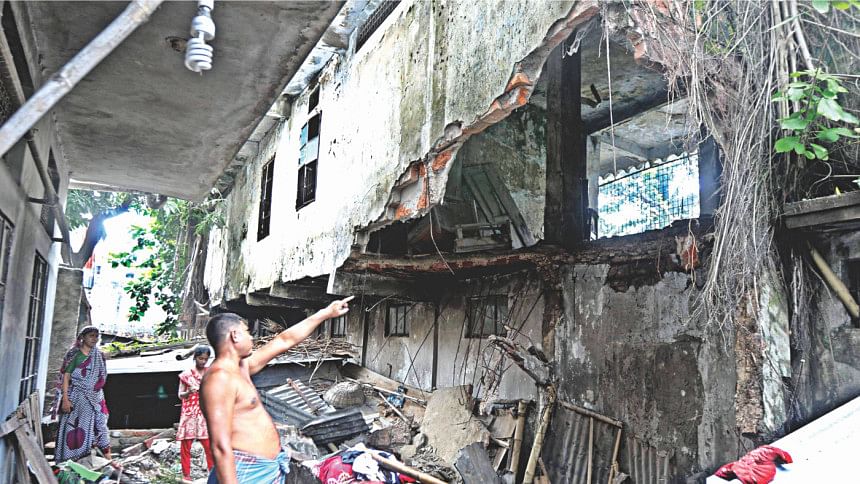Reflections of Dhaka's broken society inside a broken shelter

In a quiet corner of Mirpur, barely a kilometer away from the hustle and bustle of the Sher-e-Bangla National Stadium, lies urban Dhaka's only government shelter. It's a place that provides refuge to a wide array of individuals.
From the homeless and the lost to elderly parents who aren't welcomed by their children any more, from youngsters who need corrective measures to women and girls who need to live in a secured environment, the list goes on.
However, as opposed to the neighbouring cricket ground, the Sarkari Asroy Kendra—spread over 1.67 acres— is a lesser-known institution. One of its rare claims to fame is a short film named Nonsense, aired on ATN Bangla more than two decades ago, where it receives two minutes of coverage amidst a romantic scene enacted by Zahid Hasan and Richi Solaiman.
Here is how it plays. The character portrayed by Zahid disappears soon after the heroine falls in love with him. Days later, an advertisement in the paper states that the protagonist is found and that he is residing in a government shelter. The heroine then scampers to the shelter, brushes past the white curtains of the shelter officer's room and desperately enquires about the “love of her life”, which eventually leads to the final scene.
Unlike the rather typical plot of the film though—which ends on a happy note—the real life stories of the individuals living inside the shelter give you a lot more food for thought. They oppose the more popular notion that shelters like these are just filled with homeless people looking for shelter in the cold. The stories, on the contrary, reflect the unheard cruelties of the capital's urban society.
The case of six-year-old Mohammad Ali (not his real name), is one such example. After Ali's mother passed away, his father married again. A few months later, Ali went out with his stepmother. He was told that they were going to have lunch at a restaurant that day. Eventually, the six-year-old's stepmother left Ali in front of the Dhaka Medical College Hospital and left.
Some of the hawkers in the region took Ali to Shahbagh Police Station, from where he was sent to the shelter in Mirpur. The shelter then directed the police to go to Ali's house, as per the address given by the six-year-old. However, there was no one there. The parents, along with the stepmother's father, had apparently shifted to a new address.
The fate of eight-year-old Al-Imran (not his real name) remains uncertain. The boy's parents recently separated. His father married again. But neither of his parents were willing to keep him. With nowhere else to go, Al-Imran was sent to the shelter.
It's also a place where you find teenagers involved in stealing and mugging. Rahim and Fahad, for instance, are two brothers who would steal from railway passengers and then escape by climbing on top of the train. When the police caught them, they threatened to kill themselves by sticking blades in their own mouths. They were sent to the centre twice. They stayed for six months during their first stint and were doing well. However, as soon as they got out, they returned to their old business.
“Children like these are mentally scarred and one needs to be very careful while handling them. When they come here, we try our best to help them. For instance, we give them awards during programmes for the tasks they achieved. We make them recite poems. Things like these are entirely new to them,” explains Kamrun Nahar, Assistant Manager of the Mirpur shelter.
However, despite the corrective measures taken in the shelter, you find a number of youngsters repeatedly returning to the shelter on the direction of the police. “I think society needs to understand that this is not a jail. We often see that children who get out of here are not treated well and that's not fair because they don't get a second chance and end up returning back to their old lives,” says Kamrun.
Another reason that may be playing a role behind certain unsuccessful cases as far as the rehabilitation aspect is concerned is the lack of facilities. The shelter in Mirpur, for instance, was built in 1977 with an aim to host at least 200 individuals. Today, however, the shelter has the facilities to accommodate just 40 people in two big rooms. The reason behind that is that one of the main buildings of the complex collapsed in 2016.
The building hosted a majority of the rooms of the shelter. It collapsed on September 27, 2016 at 3 am and the fall led to the death of a 16-year-old girl who had been living in a tin shed, outside the shelter complex, behind the building. It's been one-and-a-half years since the collapse and unfortunately, the debris of the building still remains inside the complex and hasn't been cleared.
According to the Director General of the Department of Social Services (DSS), Gazi Mohammad Nurul Kabir, the department is planning to build a tin shed there to accommodate more individuals in place of the broken building.
“It's no one's fault that the broken building has not been replaced as yet. We have already got the money to build a new structure there. The government never says no as far as money is concerned. But then, everything has to go through a process. It takes some time,” explains Kabir.
There are other infrastructural issues as well. For instance, there were nine toilets that were built for the residents of this shelter, but none of them work. Today, those who reside in the centre use the toilet on the second floor, which was actually built for the shelter's officials.
The government shelter is supposed to be a corrective centre where children and adults are nursed and trained so that they don't indulge in illegal activities once they step out into the real world. However, the centre does not have any permanent doctors or psychologists that the residents can work with. Neither do they have any specialised people to deal with the elderly.
While the shelter does have one matron to deal with most of these issues, officials admit that that's not good enough. Every time someone needs severe medical attention, the resident is sent to the Dhaka Medical College Hospital. Again, the centre doesn't have its own vehicle. It has to rent CNGs for most of its daily transportation.
Juliet Begum, Director of Institution of the DSS, insists that the administration is working on expanding its capacity. “We do have doctors and psychologists who come on a contractual basis, but we don't have permanent job positions. For that to happen we will need job posts to be opened first because this is a government institution. We have asked the government to work in this regard,” she says.
Despite the difficulties, the shelter has been able to carry on its duties with the support of five other shelters located in Gazipur, Mymensingh, Narayanganj and Manikganj. The shelter at Mirpur is considered to be a reception centre where, those who arrive are either released after a few months or transferred to the other shelters for extended periods of stay. The other shelters are a lot bigger and better-equipped.
Again, it's not just teenagers who end up living in these shelters, but adults and families too. If someone needs to stay at a shelter, the person will first need to file a general diary with the police and then get that attested from a magistrate. On the other hand, individuals are also directed to the shelters by different institutions. The police or the court, for instance, may feel that a particular person needs to stay at the shelter for a few months for either corrective measures or security purposes.
The government seems to have a lot of plans to further develop the infrastructure of these shelters. They are, for instance, planning to build these centres in many more regions across the country. They are also planning to update the IT facilities in the shelters in order to allow the residents of these places to be more in touch with the mainstream arena. As the DG of the DSS, Kabir, puts it, “It will all happen in due time.”
However, judging by the amount of time that it has taken for the government to replace a mere building, the rate of progress of the development of these shelters seem questionable.
The shelters, in its present state, may not be perfect. But they do provide victims with a sense of hope and a chance to start life over. However, if quick measures to rectify the current situation are not taken, it won't take too long for that flicker of hope to fade away.

 For all latest news, follow The Daily Star's Google News channel.
For all latest news, follow The Daily Star's Google News channel. 



Comments